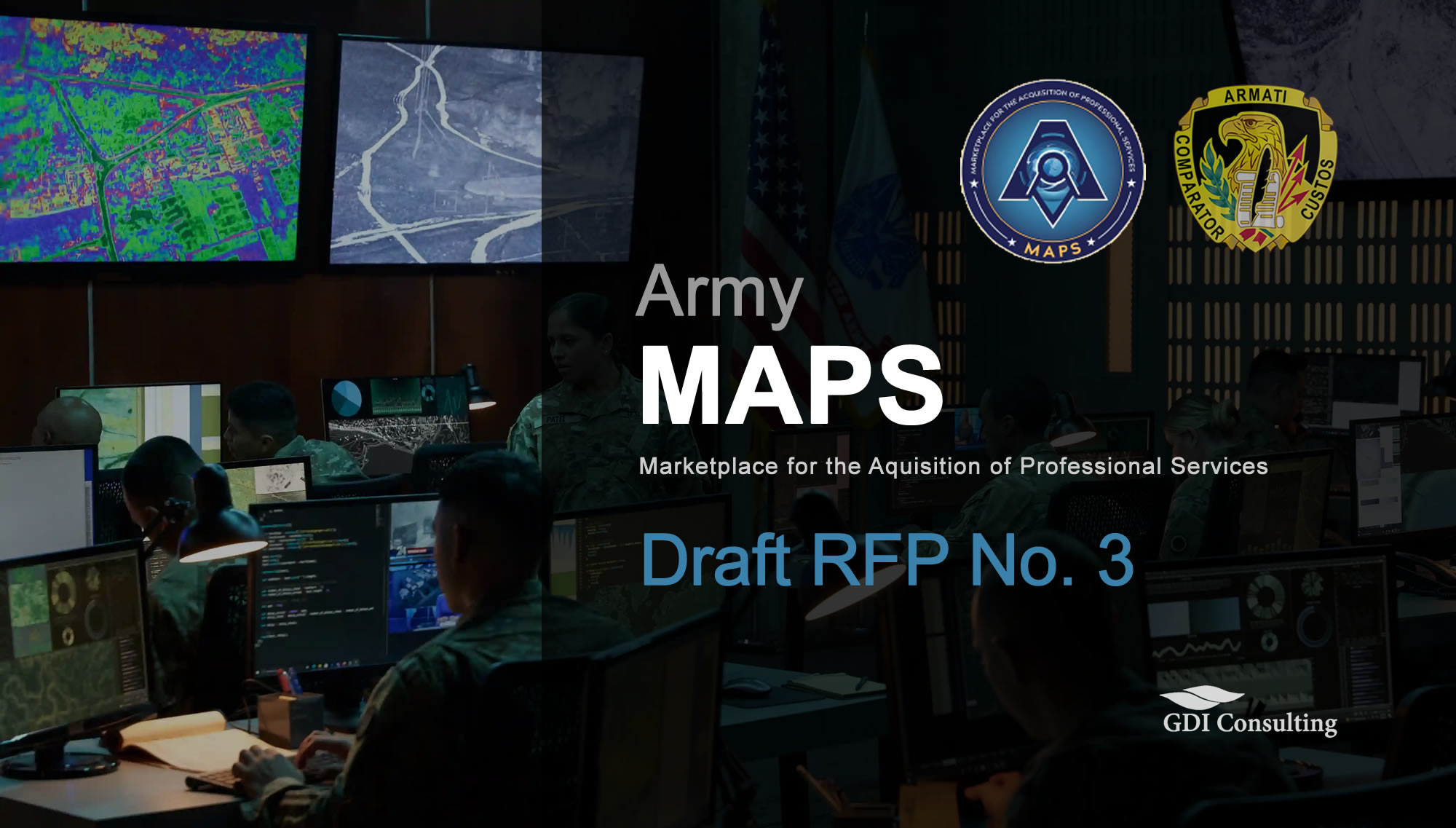The Marketplace for the Acquisition of Professional Services (MAPS) Draft RFP No. 3 has been officially released as of February 7, 2025. This draft represents a crucial milestone in the government contracting landscape, consolidating major procurement vehicles into a streamlined, efficient framework for acquiring professional services. As this solicitation moves toward its final stages, prospective offerors should carefully assess the changes introduced in this draft to ensure compliance and maximize their competitiveness.
Understanding the MAPS Draft RFP
The MAPS Draft RFP is a multiple-award Indefinite Delivery Indefinite Quantity (IDIQ) contract intended to replace and integrate the Army’s Responsive Strategic Sourcing for Services (RS3) and Information Technology Enterprise Solutions – 3 Services (ITES-3S). Administered by the Army Contracting Command – Aberdeen Proving Ground (ACC-APG) in conjunction with the Program Executive Office (PEO) CHESS, MAPS aims to optimize the procurement of professional services by enhancing flexibility, reducing redundancy, and improving cost-efficiency.
Key Features of the MAPS Draft RFP No. 3
1. Contract Structure and Duration
- The MAPS contract will have a maximum ordering period of 10 years (a five-year base period with a five-year option).
- The government reserves the right to award more or fewer than the initially planned 100 awards.
2. Domains and NAICS Codes
Offerors may bid on multiple domains, each aligned with a specific North American Industry Classification System (NAICS) code:
- Technical Services (541330)
- Management and Advisory Services (541611)
- Research, Development, Testing, and Evaluation (RDT&E) Services (541715)
- Emerging IT Services (541512)
- Foundational IT Services (541519)
Important Changes in Draft RFP No. 3
The MAPS Draft RFP No. 3 includes several notable changes from the previous iterations, aimed at enhancing clarity, compliance, and competitiveness among offerors.
1. Revised Proposal Format and Submission Requirements
- Volume I title changed from “Systems, Rates & Certifications” to “Systems, Agreements & Certifications”.
- A new Attachment 0003 is required to validate certifications, agreements, and approved systems.
- Top Secret Facility Clearance requirement added: Offerors must now provide verification of an active TOP SECRET facility clearance.
2. Past Performance (Volume II) Enhancements
- Maximum of three (3) distinct Qualifying Projects (QPs) per domain remains in place.
- Expanded eligibility: QPs may now include federal, state, local government, and private sector contracts (previously limited to federal projects).
- NAICS Alignment Specificity: QPs must align with designated NAICS codes per domain, with the flexibility to use similar codes.
3. Evaluation and Award Criteria Updates
- Determination of Responsibility Assistant (DORA): A bot will be used to assess contractor responsibility.
- Small Business Set-Asides Expanded: Reserved spots now include Small Business, Woman-Owned, HUBZone, Small Disadvantaged, and 8(a) firms.
- Tie-breaking criteria updated: Offerors with higher CPARS exceptional and very good ratings will receive preference in the event of a tie.
- New Past Performance Scoring for Dollar Value:
- 3 points for QPs over $50 million
- 2 points for QPs between $25M – $50M
- 1 point for QPs under $25 million
- Retention Rate Scoring Added: QPs will be evaluated based on employee retention rates:
- 10 points for 100% retention
- 7 points for 90-99% retention
- 4 points for 80-89% retention
- 2 points for 70-79% retention
- 1 point for 60-69% retention
- 0 points for below 59% retention
4. Gate Criteria and Final Evaluation Changes
- Gate criteria expanded: Offerors ranked in the top 20 of each domain will proceed to final evaluation.
- Final Responsibility Determination: DORA bot assessment will be used to finalize awards.
- For Large Businesses, Small Business Subcontracting Plans will be reviewed under FAR 19.704.
Proposed Timeline for MAPS Solicitation
The MAPS solicitation follows a well-defined timeline:
- February 7, 2025 – Release of Draft RFP No. 3
- April 2025 – Final Solicitation Release
- May 2025 – Proposal Due Date
- September 2025 – Evaluations Completed
- November 2025 – MAPS Award Announcements
This timeline allows prospective offerors ample time to analyze requirements, refine proposals, and address compliance factors before submission.
Strategic Considerations for Offerors
1. Aligning with MAPS Objectives
Offerors must carefully evaluate their capabilities and ensure alignment with the technical and administrative expectations outlined in the MAPS Draft RFP. The shift toward a more streamlined acquisition model presents new opportunities but also necessitates meticulous proposal preparation.
2. Strengthening Proposal Competitiveness
- Emphasize Past Performance: Given the weighted scoring on prior contracts, demonstrating a strong performance record is critical.
- Enhance Compliance Readiness: Ensure all required certifications, including ISO 9001 and CMMC Level 2 or 3, are up to date.
- Leverage Small Business Partnerships: Large businesses should prepare detailed Small Business Subcontracting Plans to remain competitive.
3. Preparing for the Evaluation Process
The evaluation structure outlined in MAPS Draft RFP No. 3 prioritizes firms with well-documented performance records, financial stability, and security clearances. Offerors should focus on providing comprehensive, well-structured proposals that address all required elements while showcasing their expertise and capabilities.
Final Thoughts on MAPS Draft RFP No. 3
The MAPS Draft RFP No. 3 introduces significant modifications aimed at improving the efficiency and transparency of federal acquisitions. By understanding these changes and proactively preparing competitive proposals, offerors can position themselves for success in this highly anticipated procurement opportunity.
For those seeking deeper insights into the MAPS Draft RFP or requiring assistance in navigating its complexities, professional guidance can be invaluable. Staying informed, proactive, and strategic will be key to securing a position within this multi-billion-dollar procurement landscape.

